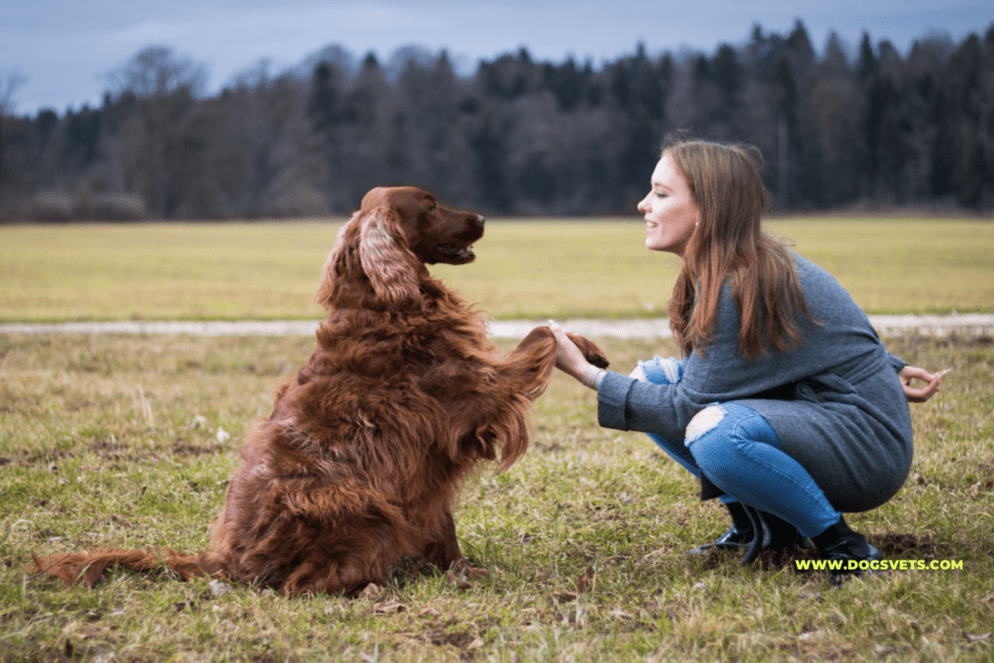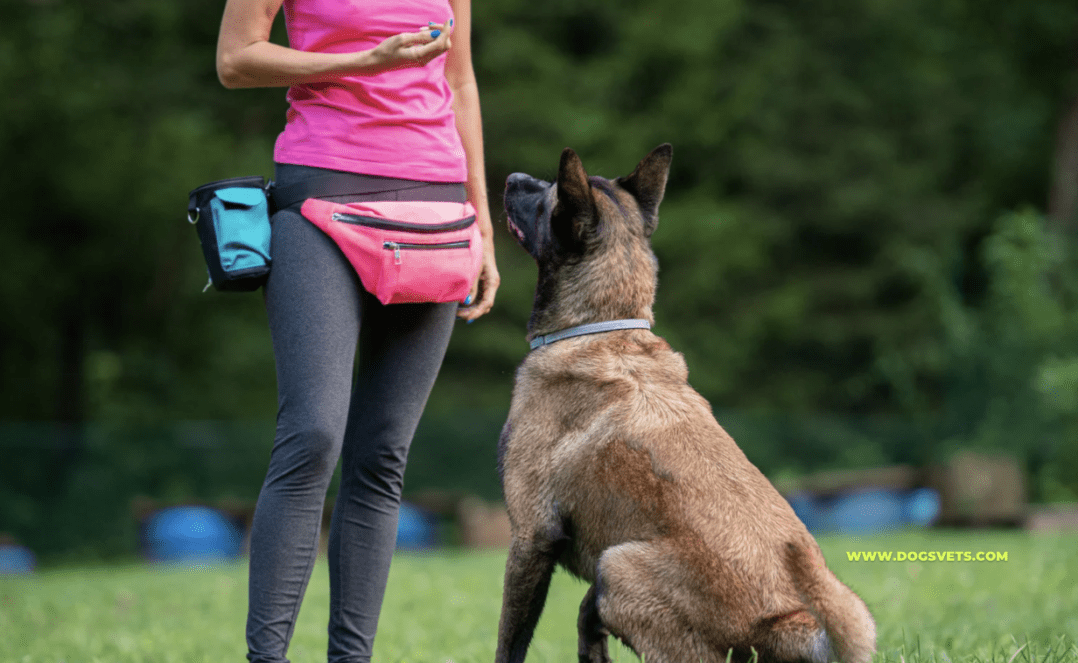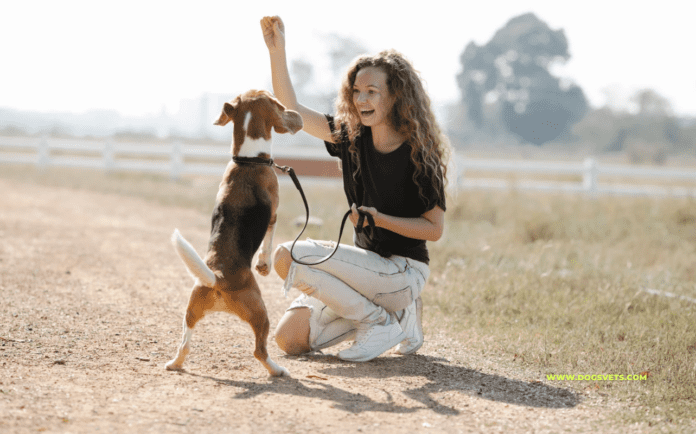Last Updated on June 3, 2023 by Dogs Vets
27 Common Dog Training Mistakes and How to Avoid Them
If you are a dog owner, you probably want your furry friend to be well-behaved and obedient. You may have enrolled your dog in a training class, read some books on dog training, or watched some videos online.
But are you training your dog in the best way possible? Or are you making some common dog training mistakes that can slow down your dog’s progress or even harm your relationship with your dog?
In this article, we will discuss some of the most common dog training mistakes that people make and how to avoid them.
We will also give you some tips on how to train your dog effectively and positively, so you can enjoy a happy and harmonious bond with your canine companion.

As a loving pet parent, you’re always looking to improve your dog’s behavior and overall well-being.
Training your furry companion is an essential part of building a strong bond, ensuring their safety, and maintaining harmony in your home.
However, there are some common dog training mistakes that can slow down progress and even create new issues.
#1: Waiting too long to start training
One of the biggest mistakes that people make is waiting too long to start training their dog.
Some people think that puppies are too young to learn anything, or that older dogs are too set in their ways to change. But the truth is, training should begin the moment your dog comes home with you, regardless of his age.
Dogs are always learning from their environment and from their interactions with you.
If you don’t teach them what you want them to do, they will learn what they want to do, which may not be what you want them to do.
For example, if you don’t teach your puppy not to bite or chew on things, he will learn that biting and chewing are fun and rewarding behaviors.

The sooner you start training your dog, the easier it will be for both of you. Young puppies are like sponges that can absorb new information quickly and easily.
Older dogs can also learn new things, as long as you use positive reinforcement and patience.
Training your dog from day one will help you prevent behavior problems, establish good habits, and build a strong bond with your dog.
#2: Not training enough or Inconsistency in Training
One of the most common mistakes in dog training is inconsistency.
Dogs thrive on routine, and a lack of consistency in your training approach can lead to confusion and slow progress.
Another common mistake that people make is not training their dog enough.
Some people think that training is something that they do once in a while, or only when they have a problem with their dog. But training is not a one-time event; it is an ongoing process that requires regular practice and reinforcement.
Dogs have short attention spans and can easily forget what they have learned if they don’t practice it often enough.
If you only train your dog once a week, or once a month, or whenever you feel like it, you will not see much progress or improvement in your dog’s behavior. You will also miss out on many opportunities to bond with your dog and have fun with him.
The best way to train your dog is to make it a part of your daily routine.
You don’t have to spend hours on end training your dog; in fact, shorter sessions are better than longer ones. Aim for 10-15 minutes of training per day, divided into two or three sessions.
You can also incorporate training into your everyday activities, such as feeding, walking, playing, or grooming your dog.
Training your dog regularly will help you maintain his skills, teach him new things, and keep him mentally stimulated and happy.
How to Avoid It:
- Establish a regular training schedule and stick to it.
- Use the same commands and hand signals each time.
- Make sure all family members are on the same page when it comes to training methods and expectations.
#3: Using the wrong methods
Another mistake that people make is using the wrong methods to train their dog.
Some people use outdated or harsh methods that rely on force, fear, pain, or intimidation to control their dog’s behavior. These methods may seem to work in the short term, but they can have negative consequences in the long term.
Using aversive methods can damage your dog’s trust and confidence in you, as well as his physical and emotional well-being.

Your dog may become fearful, anxious, aggressive, or depressed as a result of being punished or corrected harshly. Your dog may also learn to avoid or escape from the situations that cause him stress or discomfort, rather than learning how to behave appropriately.
The best way to train your dog is to use positive methods that rely on rewards, praise, encouragement, and guidance to shape your dog’s behavior.
These methods are based on scientific principles of learning and animal behavior, and they have been proven to be effective and humane by many studies and experts.
Using positive methods will help you build a trusting and respectful relationship with your dog, as well as his motivation and enthusiasm for learning.
Your dog will learn to associate training with fun and pleasure, rather than fear and pain.
Your dog will also learn to perform behaviors because he wants to please you and earn rewards, rather than because he wants to avoid punishment or correction.
#4: Punishing Your Dog for Bad Behavior
Punishment-based training methods can often do more harm than good. Dogs may not understand why they are being punished, leading to fear and anxiety instead of learning.
How to Avoid It:
- Focus on positive reinforcement techniques, rewarding your dog with treats, praise, or playtime when they exhibit good behavior.
- Redirect your dog’s energy to appropriate activities if they’re engaging in undesirable behavior.
#5. Not Providing Enough Mental and Physical Stimulation
A bored dog is more likely to develop bad habits and be less receptive to training. Ensuring your dog gets enough mental and physical stimulation is crucial for their well-being and your training success.
How to Avoid It:
- Include daily walks, playtime, and interactive toys to keep your dog engaged.
- Practice mental stimulation exercises like puzzle games, hide-and-seek, or scent work.
#6: Unrealistic Expectations
It’s important to remember that every dog is different, and their learning pace may vary. Setting unrealistic expectations can lead to frustration and may negatively impact your dog’s progress.
How to Avoid It:
- Be patient and understanding of your dog’s individual learning abilities.
- Break training sessions into smaller, manageable tasks.
- Celebrate small victories and progress along the way.
#7: Not Socializing Your Dog Early On
Socializing your dog from a young age is crucial for their overall development and can prevent future behavioral issues.
How to Avoid It:
- Expose your dog to various environments, people, and other animals from an early age.
- Enroll your pup in a puppy socialization class to help them become well-rounded and confident adults.
By avoiding these common dog training mistakes, you can create a strong bond with your furry friend and set them up for success. Remember, patience, consistency, and positivity are the keys to effective dog training. Happy training!
#8: Overlooking the Importance of Timing
Timing is crucial when it comes to rewarding or correcting your dog’s behavior. If you don’t react promptly, your dog may not associate the consequence with their action, leading to confusion.
How to Avoid It:
- Reward or correct your dog’s behavior within a few seconds of the action taking place.
- Use a clicker to mark the exact moment your dog performs the desired behavior, followed by a reward.
#9: Failing to Gradually Phase Out Treats
While treats are great motivators for training, relying on them too heavily can create a dog that only obeys when food is involved.
How to Avoid It:
- Gradually replace treats with praise, petting, or playtime as your dog becomes more reliable in their obedience.
- Use the Premack Principle to encourage good behavior with the opportunity to engage in a preferred activity.
#10. Neglecting to Train in Different Environments
Dogs don’t always generalize well, so a command learned in one environment might not be understood in another.
How to Avoid It:
- Practice training in various locations, such as your home, backyard, parks, and pet-friendly stores.
- Gradually increase the level of distractions to help your dog learn to focus on you in different situations.
#11: Skipping Basic Obedience Training
Some pet owners mistakenly believe that their dog doesn’t need formal obedience training. However, basic obedience skills lay the foundation for a well-mannered and happy dog.
How to Avoid It:
- Teach essential commands like sit, stay, come, and leave it.
- Reinforce these commands regularly to ensure they become ingrained in your dog’s behavior.
#12: Giving Up Too Soon
Training takes time, effort, and patience. Giving up too soon can result in a dog that lacks confidence and hasn’t reached their full potential.
How to Avoid It:
- Stay committed to your dog’s training, even when progress seems slow.
- Consider working with a professional dog trainer if you’re struggling or need additional guidance.
By addressing these common dog training mistakes and focusing on consistency, patience, and positive reinforcement, you can help your dog become a well-behaved, happy, and confident member of your family.
Remember, training is an ongoing process that strengthens the bond between you and your canine companion. Keep up the good work, and enjoy the journey!
#13: Ignoring Your Dog’s Body Language
Understanding your dog’s body language is essential for effective communication during training sessions. Ignoring these signals can lead to misunderstandings and setbacks in your dog’s progress.
How to Avoid It:
- Learn to read your dog’s body language and adjust your training approach accordingly.
- Pay attention to signs of stress, fear, or discomfort, and take a break or change tactics if needed.
#14: Using Incompatible Training Methods
Not every training method is suitable for every dog. Using a method that doesn’t align with your dog’s personality or learning style can hinder progress.
How to Avoid It:
- Research different dog training methods and select one that best suits your dog’s temperament.
- Be flexible and willing to adapt your approach if you find that a particular method isn’t working.
#15: Overwhelming Your Dog with Too Much Information
Bombarding your dog with multiple commands or trying to teach several new skills at once can be counterproductive, as it may overwhelm and confuse them.
How to Avoid It:
- Focus on teaching one command or skill at a time.
- Master each skill before moving on to the next.
#16: Not Practicing Recall Training
A reliable recall is one of the most important commands your dog should learn. Failing to teach or practice recall may result in potentially dangerous situations.
How to Avoid It:
- Regularly practice recall training in various environments and with different levels of distraction.
- Reinforce the recall command with positive rewards to make it a pleasurable experience for your dog.
#17: Failing to Establish Yourself as the Leader
Dogs are pack animals, and they need a clear leader to feel secure and confident. Failing to establish yourself as the leader can lead to behavioral issues and a lack of respect during training.
How to Avoid It:
- Practice leadership exercises that demonstrate your role as the decision-maker in your dog’s life.
- Set boundaries and enforce them consistently.
By addressing these additional dog training mistakes and maintaining a consistent, patient, and adaptable approach, you can create an enjoyable and effective training experience for both you and your dog.
Remember, the key to successful dog training is the bond you build with your furry friend. Celebrate your progress and cherish the time spent together as you work towards creating a well-behaved and happy canine companion.
#18: Delaying Training Until Your Dog is Older
Many people mistakenly believe that training should only begin when a dog is older. However, starting training early is crucial for building a strong foundation and preventing bad habits from developing.
How to Avoid It:
- Begin training your puppy as soon as you bring them home, starting with basic commands and socialization.
- Teach age-appropriate skills and gradually increase the level of difficulty as your puppy grows.
#19: Not Using Real-Life Situations for Training
Training should not be limited to designated sessions. Incorporating training into your daily life helps your dog generalize commands and understand their relevance in different contexts.
How to Avoid It:
- Practice commands and obedience skills during everyday activities, such as feeding, walking, or playing.
- Use real-life situations to reinforce training and help your dog understand the practical applications of the skills they’ve learned.
#20: Avoiding Proper Leash Training
Leash manners are essential for your dog’s safety and the enjoyment of your walks together. Failing to teach proper leash etiquette can lead to pulling, lunging, or other undesired behaviors.
How to Avoid It:
- Begin leash training early to establish good habits.
- Reward your dog for walking calmly by your side and discourage pulling by stopping or changing direction.
#21: Relying Solely on Verbal Commands
Dogs primarily communicate through body language, so relying solely on verbal commands during training may not be as effective.
How to Avoid It:
- Incorporate hand signals and body language into your training sessions.
- Teach your dog to respond to both verbal cues and hand signals for optimal communication.
#22: Not Adapting to Your Dog’s Changing Needs
As your dog ages or experiences life changes, their training needs may evolve. Failing to adapt your training approach to their changing needs can lead to frustration and reduced effectiveness.
How to Avoid It:
- Regularly assess your dog’s physical and mental abilities, and adjust your training approach as needed.
- Be mindful of age-related changes and adapt your training to accommodate any limitations or new requirements.
By addressing these further dog training mistakes and maintaining a consistent, compassionate, and flexible approach, you can create a fulfilling and effective training journey for both you and your dog.
Remember, successful dog training is about understanding and meeting your dog’s needs while building a strong bond. Enjoy the process and celebrate your progress as you work together towards a well-behaved, confident, and happy canine companion.
#23: Neglecting to Proof Your Dog’s Training
Proofing your dog’s training is essential to ensure they can perform commands reliably in various environments and under different levels of distraction.
How to Avoid It:
- Gradually increase the difficulty and distractions in your dog’s training sessions.
- Practice commands in different settings and with various distractions to strengthen your dog’s understanding and obedience.
#24: Not Seeking Help When Needed
Sometimes, despite your best efforts, you may encounter challenges during your dog’s training. Failing to seek help when needed can lead to frustration and stalled progress.
How to Avoid It:
- Reach out to a qualified dog trainer or behaviorist for guidance and support.
- Join a local dog training group or online community to connect with other pet parents and exchange tips and experiences.
#25: Misunderstanding Your Dog’s Motivations
Understanding what motivates your dog is crucial for successful training. Assuming that all dogs are motivated by the same rewards may not be as effective.
How to Avoid It:
- Identify your dog’s unique motivators such as food, toys, or praise.
- Use your dog’s preferred rewards during training sessions to encourage engagement and progress.
#26. Not Addressing Behavioral Issues Early
Addressing behavioral issues as soon as they arise is vital for preventing them from escalating and becoming more challenging to resolve.
How to Avoid It:
- Monitor your dog’s behavior closely and take note of any changes or concerning habits.
- Seek professional help or adjust your training approach to address behavioral issues as soon as they arise.
#27: Failing to Make Training Fun
Training should be an enjoyable experience for both you and your dog. If training sessions are monotonous or stressful, your dog may become disinterested and less likely to engage.
How to Avoid It:
- Keep training sessions short, fun, and engaging by incorporating play and varying activities.
- Be patient and maintain a positive attitude, providing plenty of praise and encouragement to make the training process enjoyable.
By addressing these additional dog training mistakes and maintaining a consistent, empathetic, and engaging approach, you can create a rewarding and effective training experience for both you and your dog.
Remember, successful dog training is about understanding your dog’s needs, motivations, and individuality while building a strong bond.
Enjoy the journey and celebrate your progress as you work together towards a well-behaved, confident, and happy canine companion.
Dog Training Questions and Answers
1. Q: What is the most important aspect of successful dog training?
A: The most important aspect of successful dog training is building a strong bond with your dog through consistent, patient, and positive reinforcement-based techniques. Understanding your dog’s unique needs, motivations, and learning style is also crucial for effective training.
2. Q: How can I teach my dog basic obedience commands?
A: To teach your dog basic obedience commands, start by choosing a quiet, distraction-free environment. Use treats, praise, or toys as rewards and practice the command in short, frequent sessions.
Be consistent with your cues and gradually increase the difficulty and distractions as your dog becomes more proficient.
3. Q: Why is socialization important for my dog?
A: Socialization is crucial for a dog’s overall development and well-being.
Proper socialization helps prevent future behavioral issues, reduces fear and anxiety, and helps your dog become a well-rounded, confident adult who can interact safely and comfortably with various environments, people, and other animals.
4. Q: When should I start training my puppy?
A: You should start training your puppy as soon as you bring them home, usually around 8 weeks of age. Early training helps establish good habits, strengthens your bond, and sets the foundation for a well-behaved, happy dog.
5. Q: How can I improve my dog’s recall?
A: To improve your dog’s recall, practice the command regularly in various environments and with different levels of distraction.
Use positive rewards like treats, praise, or playtime to reinforce the recall command and make it an enjoyable experience for your dog.
6. Q: What are some common dog training mistakes?
A: Common dog training mistakes include inconsistency in training, using punishment-based methods, not providing enough mental and physical stimulation, setting unrealistic expectations, and neglecting early socialization.
Addressing these mistakes and focusing on consistency, patience, and positive reinforcement can improve your dog’s training progress.
7. Q: How can I address behavioral issues in my dog?
A: To address behavioral issues in your dog, first identify the root cause of the problem.
Monitor your dog’s behavior closely and take note of any changes or concerning habits. Adjust your training approach or seek professional help from a qualified dog trainer or behaviorist to address the issue as soon as it arises.
Early intervention is crucial for preventing behavioral issues from escalating and becoming more challenging to resolve.
Fact Check
We strive to provide the latest valuable information for pet lovers with accuracy and fairness. If you would like to add to this post or advertise with us, don’t hesitate reach us. If you see something that doesn’t look right, contact us!






